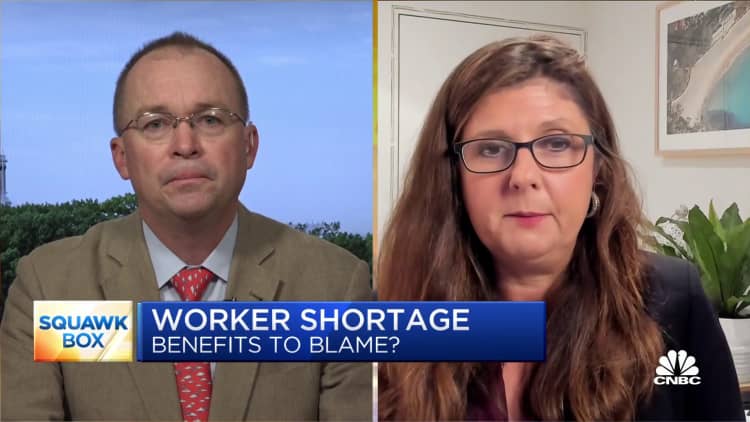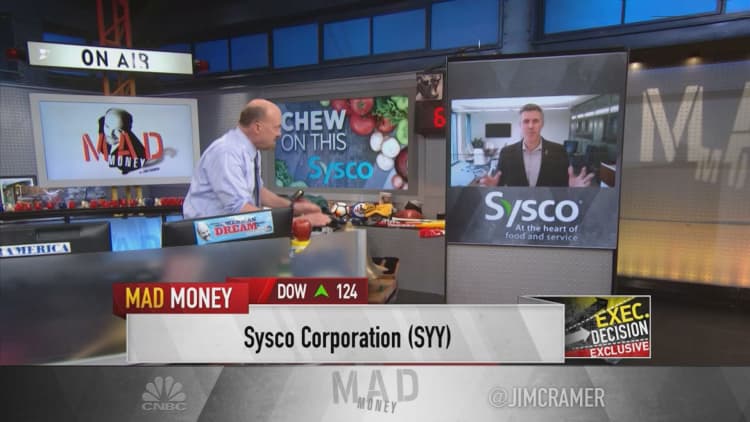Like many restaurant owners, Matt Bolus, executive chef of The 404 Kitchen in Nashville, had to get creative when the city shut down due to Covid-19 mandates last spring.
He kept some of his core staff busy by cooking meals for the local food bank, private dinners and other opportunities to pay the bills.
"You were just truly grabbing at every straw you could because you didn't know when the end was," he said.
As the city opened back up and mandates vanished, Bolus saw an influx of guests returning to the restaurant. But now he faces a huge challenge: staffing the kitchen to meet rising demand.
"The labor pool is still, unfortunately, more of a labor puddle," he said.
More from Personal Finance:
Guy Fieri is on a mission to help save restaurants hit by pandemic
Here's how these small businesses pivoted to survive during Covid
Start-ups boomed during pandemic. How some entrepreneurs found niches
The pandemic gutted the hospitality industry, which shed 2.5 million jobs in 2020, the National Restaurant Association reported.
Although restaurants have added jobs in 2021, the unemployment rate for restaurant workers is still above the national average. But despite the jobless rates in hospitality, many restaurants are still stretched to find workers.
Almost half of establishments are operating with 20% less staff than usual, the National Restaurant Association found.
Moreover, accommodations and food service job openings spiked to nearly 1 million in March, according to the Bureau of Labor Statistics.
While there have been debates over the prolonged restaurant worker shortages, some point to the enhanced unemployment benefits.
"If you talk to any restaurateurs, they will tell you that a lot of their workforce is making more money with the stimulus to stay home," said Jean Chick, U.S. restaurant and food service leader at Deloitte in Chicago.
But others blame systemic issues that have plagued the restaurant industry for years.
"The places that want to continue the old model of no benefits, low wages and poor working conditions are having the most trouble bringing in staff," said Teofilo Reyes, chief program officer at Restaurant Opportunities Centers United, a non-profit advocating for restaurant workers.
Leaving the industry
While the pandemic heightened staffing issues, restaurant worker shortages were a problem before Covid, Bolus said.
In Nashville, restaurateurs grappled with stiff competition for talent as the city welcomed a surge of new establishments. There were 112 new restaurants, bars or cafes in 2019, the third consecutive year of more than100 openings, according to the Nashville Convention & Visitors Corp.
"In the 26 years that I've been doing this, it might have been the roughest two-year patch that I've seen for hiring," Bolus said.
Nashville isn't the only city that coped with a tight hospitality labor market pre-pandemic.
"We've been in what the press has called a 'hospitality staffing crisis' for over a decade," said Ben Ellsworth, founder and CEO at GigPro, an on-demand hiring app based in Charleston, South Carolina.

After wrestling with worker shortfalls for years, Charleston restaurants veered to layoffs last March, cutting 65% of the city's 28,000 restaurant workers by mid-April 2020, according to estimates from the College of Charleston.
As workers scrambled to pay the bills, many looked for jobs elsewhere. Some employees found higher-paying jobs with landscaping or construction companies, Ellsworth said.
Pre-pandemic, experienced line cooks in Charleston were making $15 or $16 per hour. With one-bedroom apartments renting for more than $1,000 per month in the area, it's easy to see why some workers have left the industry, he said.
Health risks have also impacted the shortage, as many workers haven't felt safe returning to work, said William Dissen, executive chef and owner of Haymaker in Charlotte, North Carolina.
Restaurant workers, especially those working in a small kitchen, have been vulnerable during the pandemic. Line cooks may have been among the highest for worker mortality from March to October 2020, a study from the University of California, San Francisco found.
Since reopening back to 75% and 100%, we've really had difficulty. I put ads out almost every day.William Dissenexecutive chef and restaurateur
After mass layoffs nationwide, burnt-out restaurant workers may have taken the opportunity to pursue other career options, Ellsworth said.
More than one-quarter of kitchen workers have permanently left the industry, according to a survey of 2,000 line cooks from staffing firm Mis en Place. Some workers cited relatively low pay and long hours as reasons for leaving.
However, one-third of those surveyed say they plan to return but haven't yet for various reasons, including looking for the right opportunity (20%), Covid concerns (7%) and unemployment benefits or stimulus checks (6%).
On-demand hiring apps
Although North Carolina Gov. Roy Cooper recently lifted restrictions, many operators have failed to staff restaurants to full capacity, said Dissen, who also owns The Market Place in Asheville, North Carolina, and Billy D's Fried Chicken in Asheboro, North Carolina.
Restaurateurs often turn to Craigslist to find workers, but lately, there hasn't been sufficient response to meet rising demand, he said.
"Since reopening back to 75% and 100%, we've really had difficulty," Dissen said. "I put ads out almost every day."
As the industry continues to battle increased worker shortages, Dissen has turned to GigPro, an on-demand hiring app, to fill temporary needs, such as line cooks or dishwashers.
"It has really been just amazing for our business [in Charlotte] to be able to fill the gaps when we need it," he said.
Managers may offer higher pay for last-minute workers. For example, if a dishwasher's typical hourly rate is in the $15 per hour range, they may offer to pay $20 per hour on GigPro, Dissen said.
"I've literally filled gigs at our restaurant within 5 minutes of posting," he said.
The app also allows managers and workers to try a shift together before taking the plunge with employment, said Bolus, who has hired a handful of staff from the app.
"They've got a chance to shine or they've got a chance to leave," he said.
Downsides of on-demand hiring apps
Worker advocates say there may be some drawbacks to on-demand hiring apps, however.
"The biggest downside is that you're going to be treated as an independent contractor," Reyes said. "This means you're not subject to the few labor protections that we have under the Fair Labor Standards Act."
Another potential shortfall may be the increased risk of race or gender discrimination based on the worker's profile pictures in the app, he said.
"I think this is definitely something to monitor," Reyes said.
I think these kinds of applications are just starting and I think they're possibly going to revolutionize how we all work.Matt BolusExecutive chef of The 404 Kitchen
A 'reckoning' in the restaurant industry
Still, some restaurateurs say changes to the hiring and recruiting process may be a good thing.
"I think these kinds of applications are just starting and I think they're possibly going to revolutionize how we all work," said Bolus.
Another trend in the hiring process is offering applicants money to show up for interviews, said Chick.
"They're saying, 'we will actually give you $50 cash to show up for the interview,' and then the onus is on the owner of the restaurant to sell them on taking the position," she said.

As hiring managers test new recruiting strategies, some have noticed a shift in the dynamic between owners and workers.
"I think there's been kind of a reckoning in the restaurant industry," said Dissen.
As restaurants examine operations, there may be some steps to try and "level the playing field" between owners and employees, he said.
But it will look different for every restaurant, depending on long-term debt, products sold and how much they pay employees, he admits.
"I think it's a lot of deep questions and maybe sleepless nights to try and figure out what the answer is," Dissen said. "But I think that's how you stay viable for the future."


